“BEAR MODE” VS. LEAN: WHICH PHYSIQUE IS BETTER?
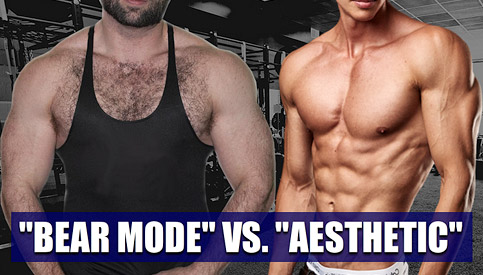
Should you go “bear mode” or focus on a leaner more “aesthetic” build?
In this article we’ll go over the pros and cons of each physique type so you can decide for yourself which one is best.
Pros And Cons Of Bear Mode
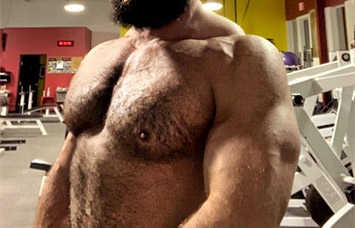
For those who don’t know, “bear mode” is an approach where the underlying goal is to fully maximize how muscular you look, with a specific goal being to look bigger in clothes.
With a bear mode physique, you’ll maintain a slightly higher body fat percentage somewhere between about 15-20%.
You’ll also emphasize certain muscle groups such as the delts, traps, neck, and forearms to really give you that strong, powerful look.
Aside from just looking bigger in general, the other advantage to bear mode is that hunger won’t be an issue since you’ll be eating more food, and you’ll also be stronger in the gym due to maintaining a higher body weight.
The downside is that you won’t appear as impressive once your shirt comes off, and your physique will just be a bit “softer” looking in general.
Pros And Cons Of The “Aesthetic” Look
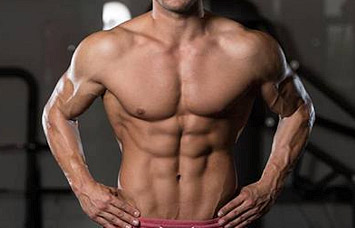
With the lean and “aesthetic” look on the other hand, you’ll be staying at a lower body fat percentage somewhere around 10-14%.
Some guys can successfully maintain a body fat level even lower than this, though that is generally the exception rather than the rule. Trying to maintain sub 10% body fat is typically not sustainable year round for the majority.
In any case, staying on the leaner end of the spectrum will give you a more impressive appearance while shirtless or in a tank top due to the increased muscle definition. You’ll probably also find that you look bigger and more muscular in photos.
The downside to the lean/aesthetic look is that if you’re trying to stay toward the bottom end of the body fat range, you’ll need to be more diligent with your diet in terms of keeping calories under control, and hunger may be an issue at some points during the day as well.
You also won’t appear as muscular in clothes, and you’ll likely experience a slight drop in overall strength.
Bear Mode Vs. Lean: Which Approach Is Superior?
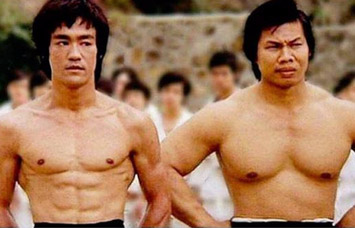
There have been plenty of discussions in the online fitness community as of late in terms of which physique is “optimal” for the average natural trainee.
The real question here is, optimal for what?
The bottom line is that as long as you’re remaining within a healthy body fat range (anywhere from 10-20% for a male), then the specific look you go with is entirely a matter of personal preference.
Just like some people prefer different hairstyles or have different clothing preferences, the type of physique you choose to maintain in terms of size versus leanness is no different.
Some people prefer the leaner “Hollywood” look and aren’t concerned with looking as big and muscular as possible. Some want that fuller, stockier look. Others (such as myself) like their physique to be somewhere in the middle.
It’s really up to you and just depends on what you think looks best.
The big misconception many people have with the bear mode physique is that they equate it with full out “dirty bulking” and simply piling on a bunch of unnecessary fat.
In reality, bear mode has nothing to do with leading an unhealthy lifestyle, cutting out cardio or allowing your diet to go off the rails.
Bear mode is simply about staying toward the higher end of the healthy body fat range.
Depending on the person and their desired physique, goals and lifestyle, that could be 16%, 18% or 20%.
The key point here though is that you’re still in a healthy range, which for a male could be span anywhere from 10-20%.
Bear mode isn’t even specifically a method for putting on muscle or a way to maximize your gains per se — bear mode is just a permanent state that you’re keeping yourself in year-round to maintain a bigger, fuller look.
Also keep in mind that the increased muscle fullness you’ll obtain with this approach is not solely due to increases in body fat. When you increase your overall calorie intake, you’ll also retain more water and store higher amounts of glycogen in your muscles which will further add to that larger, more powerful appearance.
Important Tips To Consider
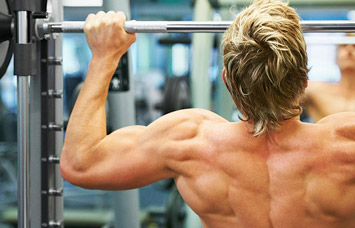
If you’re trying to decide between these two different approaches, here are a few important points to keep mind…
First off, keep in mind that going “bear mode” and eating in a larger calorie surplus to increase your body fat will not actually help you gain lean muscle at a faster rate.
Your body can only make use of a relatively small calorie surplus each day for the purpose of building muscle. Around 200-300 calories above maintenance is all that can be utilized for muscle growth.
Once you go beyond that point the rest will just be stored as fat.
Bear mode is about maintaining a higher body fat level purely because of the way it looks — not because it will somehow help you increase muscle hypertrophy.
So, once you do reach that slightly higher body fat level and achieve the bear mode look you’re after, you should then dial your calorie surplus back down to the 200-300 range to minimize further excess fat gain. Otherwise, your overall body fat is quickly going to climb up too high.
Regardless of what physique type you’re aiming for, you should always strive to remain at or below 20% body fat, since going beyond that point is where you start drifting into an unhealthy range.
Temporarily going a bit higher isn’t going to kill you, but if you are wanting to maintain a bear mode look while continuing to put on muscle, you’ll be best off to start your bulk somewhere around the 15-17% mark, implement a brief cutting phase once you get close to 20%, and then repeat.
Secondly, remember that bear mode is NOT an excuse to get fat and lazy.
As mentioned previously, bear mode is not about turning yourself into a slob and stuffing your face with massive amounts of food while laying on the couch.
You should be living a similar lifestyle regardless of whether you’re 12% or 18% body fat in terms of basing your diet around nutrient dense whole foods and including some cardiovascular activity throughout the week.
Third, understand that bear mode will not be the ideal approach if you’re still a beginner.
Beginners don’t yet have a muscular foundation in place, and trying to go bear mode without this foundation will usually just result in an unappealing “skinny fat” look.
The more muscle you carry, the leaner you’ll appear at a higher body fat percentage. This is why bear mode should only be reserved for intermediate to advanced trainees.
If you’re still a beginner in the first year or so of lifting, you’ll almost certainly be best off to stay a bit more on the leaner side and not allow your body fat percentage to drift too far beyond the mid-teens.
Lastly, if bear mode is not your preference and you’d prefer a leaner physique, you shouldn’t be trying to maintain any lower than about 10% body fat as a year-round condition.
Going under 10% body fat temporarily can be fine — and there is a small percentage of genetic outliers who can maintain sub 10% body fat without issues — but for the vast majority of natural lifters out there, dropping below 10% will usually result in unwanted side effects such as increased hunger and decreased strength, energy, mental focus and libido.
Remaining somewhere within the 10-14% range is more realistic, and I would say that for most, 12-14% will be the ideal “sweet spot” that strikes the best balance between leanness, physical and mental performance, and overall lifestyle freedom.
Bear Mode Vs. Ripped: Conclusion
At the end of the day, as long as you’re following the guidelines in this article and are staying anywhere between 10-20% body fat, then “bear mode” versus “aesthetic mode” is entirely a matter of personal preference.
There’s no right or wrong physique to aim for, and the specific look you go for comes down entirely to what you like most.
If you found this article helpful, make sure to sign up for your FREE custom fitness plan below...




